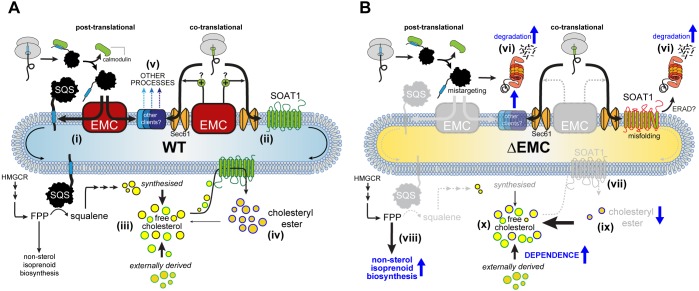Fig. 7.
Model of how EMC-mediated protein biogenesis influences cholesterol homeostasis. (A) The EMC promotes the post-translational insertion of SQS into the ER membrane (i) and maturation of SOAT1 co-translationally (ii). The correct insertion and/or maturation of EMC-dependent proteins maintain cholesterol metabolic pathways by ensuring sufficient expression of enzymes essential for cholesterol biosynthesis and storage in the form of cholesteryl esters (iii, iv). These activities enable the biosynthetic and import pathways to maintain sufficient free cholesterol in cells. Additionally, the EMC is involved directly (or indirectly) in the biogenesis of other putative membrane-bound ‘clients’ with a variety of cellular roles (v). (B) Absence of the EMC precludes SQS insertion, resulting in its premature degradation via the proteasome (vi). Similarly, SOAT1 expression is also reduced co-/post-translationally due to defective biogenesis (vi, vii). The reduction of steady-state levels of both enzymes (depicted in grey) leads to increased utilisation of the mevalonate pathway intermediate FPP for non-sterol isoprenoid biosynthesis (viii), decreased cholesterol biosynthesis and reduced capability to store cholesterol as cholesteryl ester (ix), while at the same time maintaining sufficient free cholesterol to support viability (x). The consequential loss of other EMC clients may be manifest as non-lethal impairments detectable only when targeted or monitored directly.

